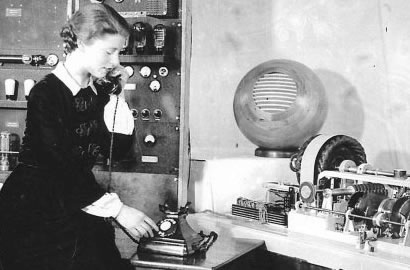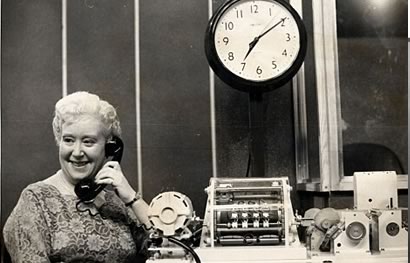The Talking Clock: Birth of the Voice-based UI
Key Takeaways
- TIM’, one of the world’s first talking clock systems, was launched in London in 1936 and was accessible to anyone with a telephone. This system is considered the world’s first mass-market, electronic data service, effectively serving as a precursor to the internet.
- The talking clock, a blend of a record player and a cuckoo clock, was a complex system made of motors, rotors, disks, and dials. It had a library of 79 unique time designations and could cater to hundreds of users a minute.
- The voice of the talking clock was selected from the Post Office’s 15,000 operators. Ethel ‘Jane’ Cain was the voice of time in the UK from 1936 to 1963, succeeded by Pat Simmons whose voice was heard by up to 400 million people a year until April 1985.
Voice-powered UI systems are everywhere we go today.
- Elevators announce floors
- Cars nag us to wear seatbelts
- Train stations recite timetable information
- Amazon Echo reads us recipes
- Siri apologizes impecably for misunderstanding our question
In fact, speaking systems are so common that we barely notice they are there. But it hasn’t always been that way.
Before Siri there was ‘TIM’
No, this isn’t a vintage deli meat slicer or an old bench saw.

This is TIM, one of the worlds’ first talking clock systems and it was launched in London in 1936. Anyone with access to a telephone could dial the ‘talking clock’ number and have the precise GMT time read to them – down to the second.
“At the third stroke, it will be ten-twenty-five and thirty seconds precisely… pip… pip… pip… .”
13 million users dialled the talking clock in its first year of operation. Everyone from station masters to bus drivers to bakers to village clock timekeepers set their time via the talking clock.
Arguably that makes ‘TIM’ the world’s first mass-market, electronic data service. Decades before the internet was even an idea, thousands of people every day were connecting to a fully-automated, networked information service.
This was your grandparent’s internet!

Of course, this was long before transistors and silicon were available, so TIM was made up of an elaborate clockwork of motors, rotors, disks and dials. The glass disks you see along the spine contain a library of 79 unique time designations – ‘five past…’, ‘six past…’, ‘seven past…’ and so on.
Essentially TIM was a complicated, large-scale blending of a record player and a cuckoo clock – but one that could talk to hundreds of users a minute.
Voice auditions were held among the Post Office’s 15,000 operators to select the ‘voice’ of the clock. Ethel ‘Jane’ Cain (above) became the voice of time in the UK from 1936 to 1963.

In 1963, the British Post launched a new generation of talking clock called the ‘Mark III’ which was voiced by the elegant tones of Pat Simmons (above). Pat’s voice would be heard by up to 400 million people a year until she was replaced by Brian Cobby in April 1985.
Though the Mark III was officially decommissioned, it was moved to the British Horological Institute Museum in 1985 where it continued to function perfectly for visitors for 20 years.
According to Alan Midleton – museum curator – one day in 2005, the motor of the Mark III developed a troubling whirring sound before finally grinding to a halt. It took technicians at British Horology Institute months to rebuild and restore it to working order.
It was only later that they discovered that Pat Simmons – then aged 85 – had passed away at exactly the same time the clock stopped.
Spooky, huh?
Originally published in the SitePoint Design Newsletter.
Frequently Asked Questions (FAQs) about Voice-Based User Interface
What is a voice-based user interface?
A voice-based user interface (VUI) is a technology that allows users to interact with systems through voice or speech commands. It’s a type of user interface that responds to vocal prompts and can understand and carry out spoken commands, eliminating the need for a physical keyboard or mouse. VUIs are commonly found in smartphones, smart home devices, and other IoT devices. They are designed to deliver a more intuitive, efficient, and satisfying user experience.
How does a voice-based user interface work?
A voice-based user interface works by converting spoken language into digital commands. This process involves several steps, including speech recognition, natural language understanding, and text-to-speech conversion. Speech recognition technology transcribes spoken words into written text. Natural language understanding interprets the meaning of the text. The system then generates a response, which is converted back into speech through text-to-speech technology.
What is the history of the speaking clock?
The speaking clock, or talking clock, has a rich history dating back to the early 20th century. The first speaking clock service was introduced in France in 1933. It was a telephone-based system that provided the exact time when dialed. The service was automated using a system of rotating glass discs where different parts of the time announcement were recorded. The speaking clock became popular in many countries and evolved with technology advancements.
How has the speaking clock evolved over time?
The speaking clock has evolved significantly over time. The early versions were telephone-based and required users to dial a specific number to hear the time. With the advent of digital technology, speaking clocks have become more sophisticated. They are now integrated into various devices like smartphones, smart speakers, and other IoT devices. Modern speaking clocks use advanced speech synthesis technology to deliver accurate time information.
What is the significance of the speaking clock in the development of voice-based user interfaces?
The speaking clock played a crucial role in the development of voice-based user interfaces. It was one of the earliest applications of speech synthesis and recognition technology. The success of the speaking clock demonstrated the potential of voice as a means of interaction with devices and systems. It paved the way for the development of modern VUIs, which are now a common feature in many digital devices.
How do modern speaking clocks work?
Modern speaking clocks use advanced speech synthesis technology to announce the time. They are often integrated into digital assistants like Siri, Alexa, and Google Assistant. When a user asks for the time, the digital assistant uses text-to-speech technology to convert the digital time data into spoken words.
What are the benefits of voice-based user interfaces?
Voice-based user interfaces offer several benefits. They provide a hands-free, eyes-free mode of interaction, making them ideal for multitasking or for people with physical disabilities. VUIs also offer a more intuitive and natural way of interacting with devices, as speaking is a fundamental mode of human communication. Furthermore, as VUI technology improves, it can understand and respond to a wider range of commands, making devices more user-friendly and efficient.
What are the challenges in developing voice-based user interfaces?
Developing voice-based user interfaces presents several challenges. Understanding human speech can be complex due to factors like accents, dialects, and speech impediments. Background noise can also interfere with speech recognition. Additionally, developing a VUI that understands context, colloquialisms, and nuances in language is challenging. Privacy is another concern, as VUIs often require access to personal data to function effectively.
What is the future of voice-based user interfaces?
The future of voice-based user interfaces looks promising. With advancements in AI and machine learning, VUIs are expected to become more sophisticated, understanding and responding to more complex commands. They are likely to become more prevalent, not just in smartphones and smart home devices, but also in cars, workplaces, and public spaces. The focus will likely be on improving the accuracy, responsiveness, and privacy of VUIs.
How can I use a voice-based user interface?
Using a voice-based user interface is typically straightforward. In most cases, you activate the VUI with a wake word or phrase, like “Hey Siri,” “Alexa,” or “Okay Google.” You then speak your command. For example, you might say, “What’s the weather like today?” or “Set an alarm for 7 AM.” The VUI processes your command and responds accordingly. It’s worth noting that the exact commands and capabilities can vary depending on the device and the specific VUI technology it uses.
Alex has been doing cruel and unusual things to CSS since 2001. He is the lead front-end design and dev for SitePoint and one-time SitePoint's Design and UX editor with over 150+ newsletter written. Co-author of The Principles of Beautiful Web Design. Now Alex is involved in the planning, development, production, and marketing of a huge range of printed and online products and references. He has designed over 60+ of SitePoint's book covers.


